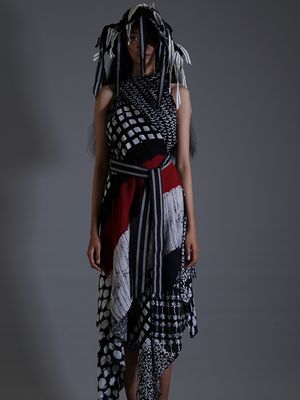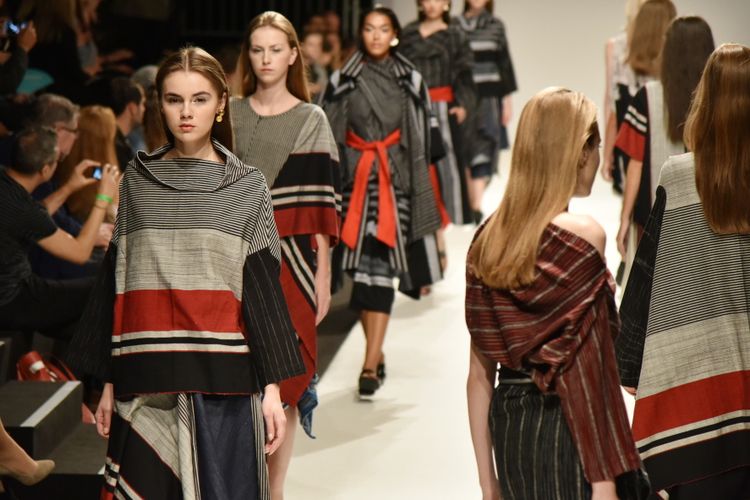Indonesia’s Lurik Fabric: From Downscale Item to High Fashion

By: Fira Abdurachman
KOMPAS.com – Indonesian fashion designer Lulu Lutfi Labibi dared to take risks when introducing the use of lurik traditional weaving fabric in high fashion about a decade ago.
From the cultural aspect, lurik which means line or stripe in the old Javanese language, was the type of fabric with rough texture for everyday wear among the commoners in the Javanese society in the old days.
“Life must go straight just like the line,” said Lulu, referring to his philosophy behind lurik. “I love straight line, as simple as that,” said the 39-year-old fashion designer.
Lulu’s interest in using lines in his design began in 2011 when he introduced the use of lurik for his fashion brand company which is named after him. To create the perfect look, he combined lurik with a unique Japanese mode style.
He then earned high appreciation from fashion magazine editorials.
Also read: Experience the Best of Bali Culture with This Full-Day Ubud Itinerary
However, his journey was not easy. In the beginning, he was struggling in selling his products as they are more segmented.
“At that time people were still not aware of my fashionwear,” he said.
He decided to post the products on Facebook in 2013. The sales started to slightly increase only when he promoted the clothing via Instagram as he gained many followers. The local customers were impressed by his clothing design, especially with the use of draping techniques.
 Indonesian fashion designer Lulu Lutfi Labibi.
Indonesian fashion designer Lulu Lutfi Labibi. Besides, the touch of Japanese mode style on the lurik traditional weaving fabric has lured the customers, making lurik a fashion trend. Since then, boutiques and retail stores in the shopping malls carry lurik traditional weaving fabric.
A status symbol in the past
Lurik is different from batik. The local artisans weave motifs into the cloth by using a non-machinery weaving tool, or popularly known by its Indonesian acronym ATBM. It is a wooden tool that is manually operated by hands.
The fabric is made of cotton thread. Based on historical literature, lurik represented social status, too. In the old days, it was a symbol of the lower class in Javanese society. It was worn by commoners such as workers, guards of Javanese palaces, peasants, and street vendors. The texture of the fabric felt rough and color choices were limited at the time.
In the 18th century, the Javanese monarchs assigned mandatory clothes based on social status. The people with low social status wore clothes with particular colors, types of fabric, and styles that are different from the royal family.
Also read: National Batik Day: Making Indonesias Art Form Relevant Even in the Time of Coronavirus
Batik expert Achmad Ilyas explained that traditional fabrics such as batik and woven fabric have evolved. In the past, the traditional fabric had detail-rich motifs and rules.
In the 1970s, Ilyas added, it was the downfall of the traditional fabric which he described the era as “dark ages.” Craftsmen who produced handmade or painted batik faced challenges in the wake of printed batik.
Later on, the late batik maestro Iwan Tirta came up with his design featuring brighter colors and modified motifs for batik in the 1980s. Since then, traditional fabrics regained their popularity and they are even regarded as formal clothes.
“Nowadays, the most important thing is the final result,” Ilyas said.
Ilyas also said that people play a significant role in determining whether a fashion design will be accepted or ignored. In the previous decades, artisans would directly contact the fashion designers to customize the designs for the market.
“A fashion designer plays a vital role to enhance the economic value of traditional fabric,” Ilyas added.
Sharing similar sentiment with Ilyas, Lulu said that he tries to bring innovation when designing the traditional weaving fabric.
Therefore, his fashion design does not follow the traditional mindset. "It's always been natural for me to act boldly, ha ha," he said.
He disagrees with the idea of labeling people. “[What happened in the past] was part of civilization but I don’t agree with assigning social status labels,” Lulu told go.kompas.com recently.
Fashionwear for everyone
In 2013, Lulu opened his boutique in Yogyakarta, the historic cultural city in Indonesia. He hired 25 workers and two lurik artisans.
 A model wearing lurik, Indonesian traditional weaving fabric, by fashion designer Lulu Lutfi Labibi.
A model wearing lurik, Indonesian traditional weaving fabric, by fashion designer Lulu Lutfi Labibi. He chose Yogyakarta because it is a suitable place for finding inspiration and a laid-back city where people preserve aspects of traditional life. “Simple is a good fortune.”
One of his loyal customers is Indonesia’s Foreign Minister Retno Marsudi. The minister often wore Lulu’s lurik weaving fabric during formal meetings. “The cloth is good on her because it represents her personality,” said Lulu.
Also read: How Indonesian Batik Became a UNESCO Intangible World Heritage
He said that his fashion design is for everyone who wants to feel comfortable. “I design clothes for everyone who feels comfortable when wearing them.”
To reach out to his customers and grow the business, he also prepared an action plan for his business strategy. “It’s not easy to take care of the baby.”
For the long-term plan, Lulu will keep the current brand instead of finding a new name.
Besides, Lulu always introduces a new design during Christmas and Idul Fitri celebration every year.
Play a key role in national economy
The Industry Ministry’s small, medium, and various industries (IKMA) acting director general Reni Yanita said that the non-machinery weaving tool (ATBM) industry, which is part of the textile and apparel industry, plays a significant role in the national economy.
 A fashion show featuring lurik, Indonesian traditional weaving fabric, by fashion designer Lulu Lutfi Labibi.
A fashion show featuring lurik, Indonesian traditional weaving fabric, by fashion designer Lulu Lutfi Labibi.Based on the small, medium, and various industries (IKMA) directorate general’s secretariat at the Industry Ministry 375 weaving centers are comprising 12,660 business units and 48,581 workers. This reflects the big potential and turnover of the traditional or hand-crafted textile industry in the country.
Last year, the textile and apparel industry sector contributed 6.76 percent to the gross domestic product (GDP) of the non-oil and gas industry. However, the growth shows a decrease this year as the textile and apparel industry has also been affected badly by the Covid-19 pandemic. In the third quarter of 2021 alone, it reached 6.09 percent. The market demand has declined due to restrictions on public activities such as people’s mobility, public events, and other ceremonies.
Reni expressed hope that things will be better. “As the tourism and economic activities start to get better, we hope people’s purchasing power and market demand for traditional textile will also be increased,” said Reni.
The ministry called on the small, medium enterprises to work together and come up with innovations as well as to adapt feasible business models. This can be done by utilizing the online marketplace as an avenue to promote the products to wider market coverage, she said.
The Ministry of Industry also continues to develop the potential of small-medium enterprises through programs on capacity building, product quality development, standardization, providing machinery or equipment as well as access to promotions and exhibitions to increase their competitiveness.
In the textile and apparel industry, fashion designers are among the stakeholders who play a vital role in the development of the SMEs and creative economy sector. As for Lulu, his interest in promoting lurik traditional fabric in high fashion, not only contributes to the national economy but also preserves the ancestral cultural heritage.
Simak breaking news dan berita pilihan kami langsung di ponselmu. Pilih saluran andalanmu akses berita Kompas.com WhatsApp Channel : https://www.whatsapp.com/channel/0029VaFPbedBPzjZrk13HO3D. Pastikan kamu sudah install aplikasi WhatsApp ya.

































